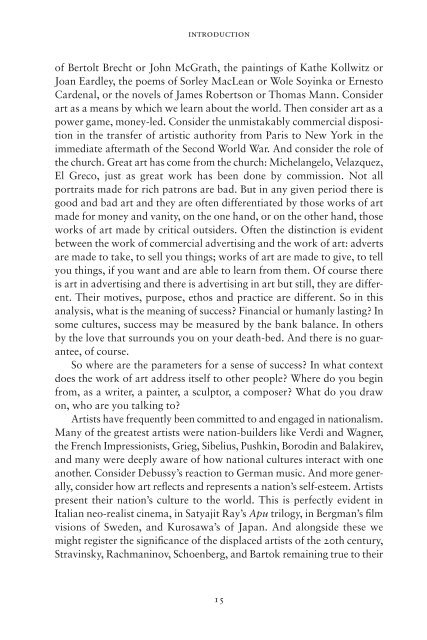Arts of Independence by Alexander Moffat and Alan Riach sampler
ALEXANDER MOFFAT and ALAN RIACH take a hard look at the most neglected aspect of the argument for Scotland’s distinctive national identity: the arts. Their proposition is that music, painting, architecture and, pre-eminently, literature, are the fuel and fire that makes imagination possible. Neglect them at your peril. For Moffat and Riach, jobs, health and trade are matters of material fact that need to be enlivened by imagination. How can we organise society to help us approach what the arts have to give. Why have we been so poor at representing our arts comprehensively, both within Scotland and internationally? What can be done? How might things be different? The arts are of paramount importance in the modern world. Moffat and Riach take the argument out of the hands of politicians and economists and beyond the petty squabbles of party politics.
ALEXANDER MOFFAT and ALAN RIACH take a hard look at the most neglected aspect of the argument for Scotland’s distinctive national identity: the arts. Their proposition is that music, painting, architecture and, pre-eminently, literature, are the fuel and fire that makes imagination possible. Neglect them at your peril. For Moffat and Riach, jobs, health and trade are matters of material fact that need to be enlivened by imagination. How can we organise society to help us approach what the arts have to give. Why have we been so poor at representing our arts comprehensively, both within Scotland and internationally? What can be done? How might things be different? The arts are of paramount importance in the modern world. Moffat and Riach take the argument out of the hands of politicians and economists and beyond the petty squabbles of party politics.
- No tags were found...
Create successful ePaper yourself
Turn your PDF publications into a flip-book with our unique Google optimized e-Paper software.
introduction<br />
<strong>of</strong> Bertolt Brecht or John McGrath, the paintings <strong>of</strong> Kathe Kollwitz or<br />
Joan Eardley, the poems <strong>of</strong> Sorley MacLean or Wole Soyinka or Ernesto<br />
Cardenal, or the novels <strong>of</strong> James Robertson or Thomas Mann. Consider<br />
art as a means <strong>by</strong> which we learn about the world. Then consider art as a<br />
power game, money-led. Consider the unmistakably commercial disposition<br />
in the transfer <strong>of</strong> artistic authority from Paris to New York in the<br />
immediate aftermath <strong>of</strong> the Second World War. And consider the role <strong>of</strong><br />
the church. Great art has come from the church: Michelangelo, Velazquez,<br />
El Greco, just as great work has been done <strong>by</strong> commission. Not all<br />
portraits made for rich patrons are bad. But in any given period there is<br />
good <strong>and</strong> bad art <strong>and</strong> they are <strong>of</strong>ten differentiated <strong>by</strong> those works <strong>of</strong> art<br />
made for money <strong>and</strong> vanity, on the one h<strong>and</strong>, or on the other h<strong>and</strong>, those<br />
works <strong>of</strong> art made <strong>by</strong> critical outsiders. Often the distinction is evident<br />
between the work <strong>of</strong> commercial advertising <strong>and</strong> the work <strong>of</strong> art: adverts<br />
are made to take, to sell you things; works <strong>of</strong> art are made to give, to tell<br />
you things, if you want <strong>and</strong> are able to learn from them. Of course there<br />
is art in advertising <strong>and</strong> there is advertising in art but still, they are different.<br />
Their motives, purpose, ethos <strong>and</strong> practice are different. So in this<br />
analysis, what is the meaning <strong>of</strong> success? Financial or humanly lasting? In<br />
some cultures, success may be measured <strong>by</strong> the bank balance. In others<br />
<strong>by</strong> the love that surrounds you on your death-bed. And there is no guarantee,<br />
<strong>of</strong> course.<br />
So where are the parameters for a sense <strong>of</strong> success? In what context<br />
does the work <strong>of</strong> art address itself to other people? Where do you begin<br />
from, as a writer, a painter, a sculptor, a composer? What do you draw<br />
on, who are you talking to?<br />
Artists have frequently been committed to <strong>and</strong> engaged in nationalism.<br />
Many <strong>of</strong> the greatest artists were nation-builders like Verdi <strong>and</strong> Wagner,<br />
the French Impressionists, Grieg, Sibelius, Pushkin, Borodin <strong>and</strong> Balakirev,<br />
<strong>and</strong> many were deeply aware <strong>of</strong> how national cultures interact with one<br />
another. Consider Debussy’s reaction to German music. And more generally,<br />
consider how art reflects <strong>and</strong> represents a nation’s self-esteem. Artists<br />
present their nation’s culture to the world. This is perfectly evident in<br />
Italian neo-realist cinema, in Satyajit Ray’s Apu trilogy, in Bergman’s film<br />
visions <strong>of</strong> Sweden, <strong>and</strong> Kurosawa’s <strong>of</strong> Japan. And alongside these we<br />
might register the significance <strong>of</strong> the displaced artists <strong>of</strong> the 20th century,<br />
Stravinsky, Rachmaninov, Schoenberg, <strong>and</strong> Bartok remaining true to their<br />
15


















